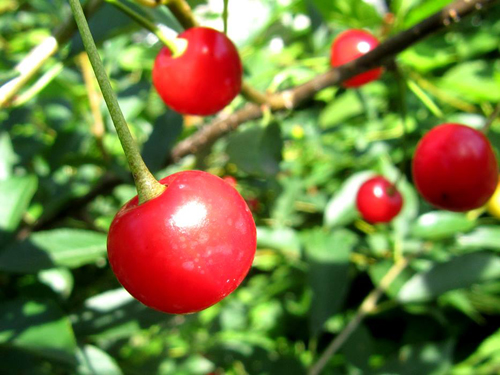Cherry variety Asterisk
In central Russia, there are quite a few good varieties of cherries with uncertain origins. Nevertheless, they are grown for a long time, do not skimp on the harvest, and withstand adverse weather conditions with dignity. These include the Asterisk (not to be confused with the Star variety). Our heroine is not included in the State Register of Breeding Achievements. It is known about the origin of the plant that it appeared due to the selection of cherry seedlings from the nursery of I.V. Michurin, therefore, it is impossible to trace the parental line. Due to the lack of a description in official sources, it is quite difficult to compose a complete portrait of our heroine.

Description
The plant is medium or tall, depending on the growing conditions and stock. The average height is about 3.5 meters. The bark is red-brown with a grayish bloom. Lentils on the shoots are light, not large, their number is insignificant. The crown is medium thickened, resembling a pyramid in outline - narrowed at the top and wide at the bottom. Own-rooted plants have a powerful root system. Average leafiness. The leaves are large, not hard to the touch, with a serrated edge, green in color. The shape is oval, with a short-pointed apex and a slightly rounded wedge-shaped base. The petiole is long, not thick. The petiole and central vein are not stained. The glands are small, at the base of the leaf. The inflorescence consists of several large white saucer-shaped flowers. Fruiting occurs mainly on the growths of the last year.
Cherry drupes are round, rather large, weighing 4.0 - 5.0 grams, up to 20 mm in diameter. The skin is glossy, thin, of bright scarlet color. Zvezdochka's pulp is light red, delicate, juicy, with a cherry aroma. The taste is refreshing, sweet, with a pleasant sourness. The tasters rated it at 4.0 - 4.2 points. The juice is pink. The peduncle is of normal size, unpainted. The stone is light, yellow, large, easily separated from the pulp.
Characteristics
- Due to the good early maturity, it will be possible to get acquainted with the taste of the berries of this variety within 3-4 years after planting the seedling;
- the beauty blooms in May;
- if we take into account that the early varieties of culture, for example, Molodezhnaya or Shokoladnitsa, ripen already in mid-June, then in terms of ripening our heroine is more of a mid-early one. Ripening of fruits occurs at the beginning of July. Of course, the weather plays an important role in this process;
- cherry productivity is average. Gradually increasing the yield, by the age of ten the tree bears 18 - 20 kg of berries. But this indicator is not at all bad, considering that the variety does not disappoint with the frequency of fruiting;
- thanks to the powerful root system, the tree can independently provide itself with moisture, therefore, the plant tolerates short periods of drought quite well;
- the zoned culture has excellent frost resistance. In the recommended growing region, she is not afraid of lowering winter temperatures down to -36 ° C. It is noted that the vegetative and generative buds are not affected;
- there is no specific information on immunity. Some sources claim that Asterisk has sufficient resistance to fungal diseases and various pests. But at the same time, there is evidence that the variety can be affected by coccomycosis and moniliosis in unfavorable years. In any case, keeping the trunk circle clean reduces the risk of spreading diseases and pests;
- delicate berries will not withstand long-term transportation. But it is possible to transport the crop from the dacha to the house quite successfully, especially if the fruits were removed with part of the stalk. The keeping quality is insufficient, but the berries will lie in the refrigerator for a little more than 2 weeks;
- the way of use is universal. Due to its refreshing sweet and sour taste and rich vitamin composition, cherries are often consumed in their natural form. Also, the crop is successfully used for processing into jam, jam, liqueur, compote. Freezing is a great way to prolong the consumption of natural berries.
Pollinators
The asterisk is attractive in that it belongs to the partially self-fertile varieties. Even in a single planting, a crop is formed, however, one cannot count on the full return in this case. An excellent way to increase the yield and quality of fruits is to plant pollinators suitable for our heroine - Wreath, Seedling No. 1. Some sources claim that some varieties of sweet cherries are suitable for cross-pollination of our variety.
Planting and leaving
Cherry planting is recommended in spring. Of the soils, light and medium nutritious loams with neutral acidity and good moisture permeability are preferred. The requirements for agricultural technology are common. The only caveat is the need for timely thinning pruning, thanks to which the crown is better blown out and thereby the spread of fungal infections is kept under control.
The asterisk is a very successful and unpretentious variety for central Russia. The plant tolerates various weather surprises - possible periods of drought, frost. True, in wet weather, an outbreak of coccomycosis is possible, therefore, preventive examinations and treatment should be carried out in full. The crop not only yields an annual harvest, but is itself a reliable pollinator for other varieties of cherries.








